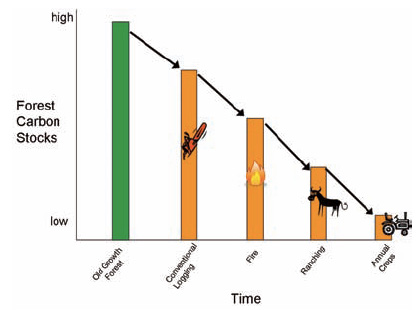|
|
Selective logging, understory fires, fuelwood harvesting, and other forms of forest degradation are a substantial source of greenhouse has emissions, reports a policy brief issued by The Nature Conservancy (TNC) at U.N. climate talks in Bonn, Germany.
The brief, titled “Don’t Forget the Second ‘D’: The Importance of Including Degradation in a REDD Mechanism”, says that forest degradation is often overlooked by policy makers, but accounts for a large share of emissions, including at least 500 million tons of C02 per year from selective logging alone. TNC highlights research showing that logging in the Brazilian Amazon generates 20 percent of the region’s emissions while in some years fire can cause 10-45 percent of total forest carbon emissions. The brief also notes that degradation—which can include reduction of any amount up to 90 percent of forest canopy cover—is often a precursor to deforestation.
 Forest transitions often start with degradation before complete conversion. The phases and timing of these transitions depend upon location. For example, in Indonesia, oil palm or other tree crops may replace ranching. Image and caption courtesy of TNC |
Given the significance of degradation in both emissions and deforestation, TNC says that the “degradation” component of REDD must explicitly dealt with. Failure to do so will reduce the effectiveness of the mechanism in mitigating climate change. It would also undermine efforts to preserve biodiversity, since many species cannot survive in heavily degraded forest landscapes.
TNC says a framework that effectively addresses degradation will also pay dividends for rural populations, some of whom are among the poorest and most natural resource-dependent in the world.
“Incorporating degradation into a REDD framework is also critical for channeling incentives to the diverse range of stakeholders involved in the spectrum of activities that determine the fate of forests and their carbon emissions,” stated the brief.
Challenges
But addressing degradation won’t be easy. Monitoring degradation has long been a technical challenge but new technologies, including The Carnegie Landsat Analysis System (CLAS), a method for evaluating forest cover using satellite imagery, and high resolution remote sensing technologies like Lidar, are greatly improving measurement and tracking.
Further challenges will result from poor governance over forest resources. To help address this, TNC says funds from the early stages of a REDD mechanism should go support institutional reform and capacity building in developing countries to increase transparency, simplify administration, improve land tenure systems, and foster cross-sector collaboration between governmental agencies.
TNC identifies practices in forest areas that can reduce degradation including fire management approaches to minimize the impact of catastrophic forest fires and sustainable forest management as a means to reduce emissions from forest exploitation. Reduced impact logging (RIL) techniques can reduce emissions by 30-50 percent relative to conventional selective logging methods by cutting peripheral damage during harvesting. TNC says RIL can be encouraged by certification schemes (like the Forest Stewardship Council that offer a premium for producers.
But some environmentalists are concerned by any form of logging of old-growth forests, which are store more carbon and house higher levels of biodiversity than logged forests.
“If carbon monies pay for non-existent ‘sustainable management’ and other industrial development of primary forests, replacing them with plantations and much diminished secondary forests (both in terms of biodiversity and carbon), it will facilitate the biosphere’s continued decline,” said Glen Barry, an activist who runs Ecological Internet and Forests.org.
A new report from Global Witness, titled “Vested Interests – Industrial logging and carbon in tropical forests“, expresses a similar worry.
“Industrial logging is a major source of carbon emissions, a primary driver of deforestation and threatens to derail the UN process to reduce deforestation,” Global Witness warned in the report.
The Ecosystems Climate Alliance (ECA), a coalition of activist and environmental organizations that includes Global Witness — agrees that the impact of logging depends largely on forestry rules and governance structures.
The Environmental Investigation Agency (EIA), a member of the ECA that works on international trade and demand issues, believes a framework on REDD should incorporate rules for demand in consuming countries, since deforestation is as much driven by market demand in industrialized nations as it is by poverty in developing nations.
“My major concern is that until we talk about these demand issues in a meaningful way, we aren’t talking about a real solution,” EIA Forest Campaigns Director Andrea Johnson said.
Johnson believes funds for supplemental activities under the Waxman-Markey bill could be directed towards joint implementation of demand-side laws like the U.S. Lacey Act, which is used to fight illegal logging by requiring companies to respect environmental laws in the countries from which they obtain plant and wildlife products.